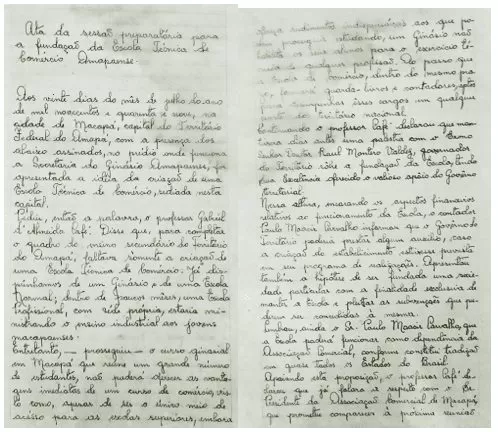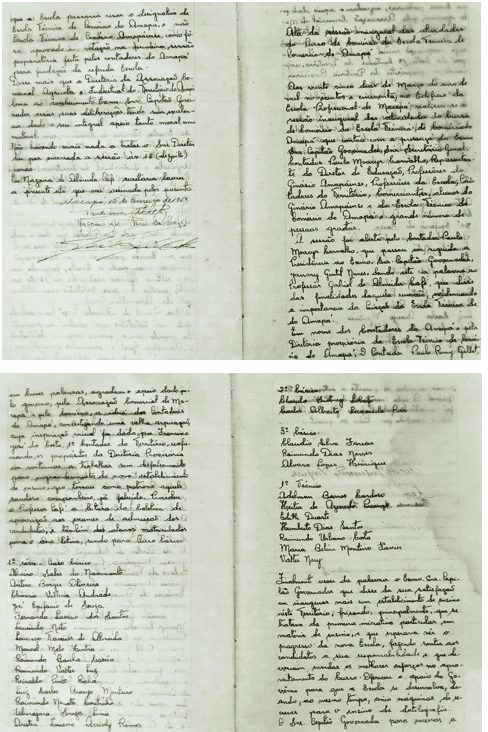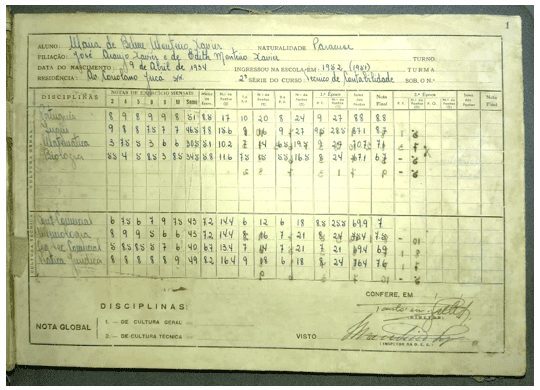ORIGINAL ARTICLE
LOBO, Géssica dos Anjos [1], FECURY, Amanda Alves [2], DENDASCK, Carla Viana [3], OLIVEIRA, Euzébio de [4], DIAS, Claudio Alberto Gellis de Mattos [5]
LOBO, Géssica dos Anjos. et al. The technical school of commerce: a bit of Professional and Technological Education (EPT) in Amapá. Revista Científica Multidisciplinar Núcleo do Conhecimento. Ano. 07, Ed. 05, Vol. 02, p. 05-12. May 2022. ISSN: 2448-0959, Available in: https://www.nucleodoconhecimento.com.br/education/ept-in-amapa, DOI: 10.32749/nucleodoconhecimento.com.br/education/ept-in-amapa
ABSTRACT
Historically, work relationships play a role in the establishment of social and productive relationships. At school, for example, education for physical and intellectual work was different. Manual education was intended for physical work and so-called propaedeutic education for purely intellectual work. In 1943, the Federal Territory of Amapá was created, through decree-law n. 5,812 of September 13th. The Escola Técnica do Comércio do Amapá was founded on September 13, 1949. It was a joint idea of the Associação Comercial do Amapá and some teachers. The vocational school was then implemented. The objective of this work was to show the participation of the Escola Técnica do Comércio do Amapá in the history of Professional and Technological Education (EPT)[6] in the state. A documentary search was carried out in the state archives of the Escola Gabriel de Almeida Café, located on FAB Avenue, in Downtown, Macapá, Amapá. A further analysis based on the literature took place. The foundation of the technical school in Amapá, even using dualist principles, provided the basis for professional education in the state. The Instituto Federal de Educação, Ciência e Tecnologia do Amapá (IFAP) is part of a national network that used these schools as a foundation. However, by offering technical and technological education to highly trained students and with access to the less affluent population, it collaborates a lot in reducing educational duality and, therefore, in reducing the Brazilian social difference.
Keywords: Teaching, EPT, Technical School.
INTRODUCTION
Historically, work relationships play a role in the establishment of social and productive relationships. There are those who live off the work of others (bosses) and those who sell their work capacity (employees) (CEZAR and FERREIRA, 2016).
Socially, this relationship has a double identity. At school, for example, education for physical and intellectual work was different. Manual education was intended for physical work and so-called propaedeutic education for purely intellectual work (SAVIANI, 2007).
This “historical educational duality” derived an education for work, aimed at the less favored layer of the population, forming a workforce without a college degree. On the other hand, for people with more access, education would be at a higher level, thus being better paid. This does not collaborate with the reduction of the social interval (MOURA, 2007).
During the imperial period in Brazil, religious and philanthropic associations were responsible for training the workforce. Helpless minors were destined to serve the armed forces through the Companhias de Aprendizes Artífices e as Companhias de Aprendizes de Marinheiros (MANFREDI, 2002; GARCIA et al., 2018).
In 1943, the Federal Territory of Amapá was created, through decree-law n. 5,812 of September 13th. The idea was to mark the country’s borders, even more so, those considered strategic when considering the war period (World War II) (SANTOS, 2006).
Along with the idea of preserving the national territory, there was also the vision of exploring natural resources. In the Vargas era, it was intended to develop the Brazilian regions and form a modern and industrial national state, using the workforce. Thus, there was an incentive to create these workers, within the capitalist principle (SILVA, 2007; LOBATO, 2014).
The Escola Técnica do Comércio do Amapá was founded on September 13, 1949. It was a joint idea of the Associação Comercial do Amapá and some teachers. A professional school was implemented where, until then, only teachers were trained (AMAPÁ, 1946).
OBJECTIVE
Show the participation of the Escola Técnica do Comércio do Amapá in the history of Professional and Technological Education (EPT) in the state.
METHOD
A documentary search was carried out in the state archives of the Escola Gabriel de Almeida Café, Avenue FAB, Downtown, city of Macapá, state of Amapá. A further analysis based on the literature took place.
RESULTS AND DISCUSSIONS
From 1937 to 1945, Brazil was led by Getúlio Vargas. During this period, imports are reduced, which requires the formation and training of a working class (working class) to meet the new directions of industrialization (MANFREDI, 2002).
In the Federal Constitution of 1937, the State places professional education as its duty. However, it defines, contradictorily, that industries and unions must create training schools, within each specialty necessary for production. The Brazilian State then subsidized these entities for such an offer (BRASIL, 1937).
The laws created to organize vocational education ended up configuring the separation between this teaching and the propaedeutic, organizing it by areas (MANFREDI, 2002; BRASIL, 2008).
When the territory of Amapá was created, the first governor sworn in was Janary Gentil Nunes, appointed by President Getúlio Vargas. He governed the territory between 1944 and 1956, with intermittent periods to assume federal positions (COELHO, 2004).
Its government policy was based on three pillars: cleaning, educating and populating. In this way he began to build the necessary structures, mainly by increasing the number of schools and improving public health. The work of the population, at the time, followed the logic of daily subsistence, without medium or long-term planning (COELHO, 2004).
The governor initially intended to overcome the high number of illiterates. In the beginning, there were few schools in Amapá, most being concentrated in the capital (LOBATO, 2009). So he set goals for education and was financed by the Vargas government, which had political interests in this educational project. Thus, the levels of education were expanded, as well as the installation of professional education (AMAPÁ, 1946; LOBATO, 2014).
A 1944 report, prepared by the government of Amapá, indicated that formal education did not qualify young people for technical jobs, thus there was a need for such training. For the development of production and the economy of the state, a diversified technical class should be formed (AMAPÁ, 1946).
With the installation of the territory of Amapá and the increase in extractivism, there was also an increase in the variety and number of commercial houses, to serve the growing population. Commerce was still not very diversified, but it encouraged the natives of the state to live with commerce and the idea of consumption (AMAPÁ, 1946).
There was then an increase in commercialization, including the exchange of goods, which boosted the increase in the quantity and variety of commercial products in the territory of Amapá. Thus, new types of work also emerged, which required specialized labor (AMAPÁ, 1946).
In the Nunes government’s conception, any location could be used as an incentive to study. In this way churches, shops, medical centers and sports venues were used for this purpose (AMAPÁ, 1946).
But, in the assemblies that asked for government aid for the foundation of the Escola Técnica de Comércio Amapaense, the support of the state was configured in the transfer of a room of a state school. In this scenario, the Associação Comercial founded the Escola Técnica do Comércio, together with professors and some accounting professionals (AMAPÁ, 1946).
The technical school initially trained “bookkeepers” and “accountants” (Figure 1).
Figure 1 – Minutes that discuss and implement the foundation of the Escola Técnica de Comércio Amapaense in 1949

Classes began in 1950 and, to enter, the student took an admission test, offered annually. There was a choice between the “entry-level trade course” and the “technical course in accounting” (Figure 2).
Figure 2 – Minutes showing the beginning of activities, the first courses offered and the first ones approved in each course

The federal government used the same policy to implement technical education in all territories of the Union (BANDEIRA, 2015).
In the first year of normal operation of the school, in 1950, the courses of 1st, 2nd and 3rd series of the basic commercial course and 1st series of technician in accounting were offered (Figure 2). In the courses, the subjects were separated into General Culture (Portuguese, English, Mathematics, Geography and History) and Technical Culture, with different subjects according to the modality of the commercial education course series (Figure 3).
Figure 3 – Sheet that shows the subjects of a student of the technical course in accounting

This beginning of education throughout the country seems to have founded, even with some erroneous biases, the EPT in Amapá. Currently, the Federal Institutes, including the one in Amapá (IFAP), act in an attempt to reduce the difference in access to quality education (NUNES and WETTERICH, 2019). They allow students to access higher academic and technological levels. This seems to be a way to reduce the Brazilian educational duality (MOURA, 2007).
CONCLUSIONS
The foundation of the technical school in Amapá, even using dualist principles, provided the basis for professional education in the state.
The Instituto Federal de Educação, Ciência e Tecnologia do Amapá (IFAP) is part of a national network that used these schools as a foundation. However, by offering technical and technological education to highly qualified students and with access to the less affluent population, it collaborates a lot in reducing educational duality and, therefore, in reducing the Brazilian social difference.
REFERÊNCIAS
AMAPÁ. Relatório de atividades do Gôverno do Território Federal do Amapá, em 1944. Rio de Janeiro RJ: Imprensa Oficial: 246 p. 1946.
BANDEIRA, T. D. S. Escola técnica do comércio união caixeiral: Contextos de uma criação. Revista do CERES, v. 1, n. 1, p. 72 – 77, 2015.
BRASIL. Constituição Dos Estados Unidos Do Brasil 1937. Rio de Janeiro RJ: Casa Civil 1937.
______. Cem anos da rede de educação profissional. Brasília DF, 2008. Disponível em: < http://portal.mec.gov.br/setec/arquivos/centenario/historico_educacao_profissional.pdf >. Acesso em: 25 mai 2020.
CEZAR, T. T; FERREIRA, L. S. A relação entre educação e trabalho: um contexto de contradições e a aproximação com a educação profissional. Revista Ibero-Americana de Estudos em Educação. Araraquara, v. 11, n. 4, p. 2141–2158, 2016. DOI: 10.21723/riaee.v11.n4.8248. Disponível em: <https://periodicos.fclar.unesp.br/iberoamericana/article/view/8248>
COELHO, M. C. De caboclo a brasileiro: Estado e nacionalidade no território federal do Amapá. João Pessoa PB, 2004. Disponível em: < https://periodicos3.ufpb.br/index.php/srh/article/view/11292/6406 >. Acesso em: 01 fev 2022.
GARCIA, A. D. C. et al. Educação Profissional No Brasil: Origem E Trajetória. Revista Vozes dos Vales, n. 13, p. 1-18, 2018.
LOBATO, S. S. Educação na Fronteira da Modernização: a política educacional no Amapá (1944-1956). 2009. 159p. (Mestrado). Pontifícia Universidade Católica de São Paulo, São Paulo SP.
______. Federalização da fronteira: a criação e o primeiro governo do Amapá (1930-1956). Revista Territórios e Fronteiras, v. 7, n. 1, p. 272-286, 2014.
MANFREDI, S. M. Educação Profissional no Brasil. São Paulo SP: Cortez Editora, 2002. 317p.
MOURA, D. H. Educação básica e educação profissional e tecnológica: Dualidade histórica e perspectivas de integração Holos, n. 2, p. 4-30, 2007.
NUNES, A. M. D. S.; WETTERICH, C. B. A dualidade da educação no Brasil e os dez anos do Instituto Federal de educação, ciência e tecnologia do Norte de Minas Gerais: Uma Proposta De Travessia. Educação Profissional e Tecnológica em Revista, v. 3, n. 2, p. 99-120, 2019.
SANTOS, F. R. História do Amapá: da autonomia territorial ao fim do janarismo (1943-1970). 2ed. Macapá AP: Grafinorte, 2006. 220p.
SAVIANI, D. Trabalho e educação: fundamentos ontológicos e históricos. Revista Brasileira de Educação, v. 12, n. 34, p. 152-165, 2007.
SILVA, M. L. D. A (Onto)Gênese da nação nas margens do território nacional: o projeto janarista territorial para o Amapá (1944-1956). 2007. 180p. (Mestrado). Pontifícia Universidade Católica de São Paulo, São Paulo SP.
APPENDIX – FOOTNOTE
6. Educação Profissional e Tecnológica (EPT).
[1] Degree in History, Specialist in Special and Inclusive Education, Student of the Graduate Program in Professional and Technological Education (PROFEPT IFAP).
[2] Biomedical, Doctor in Tropical Diseases, Professor and researcher at the Macapá Campus Medicine Course, Universidade Federal do Amapá (UNIFAP).
[3] PhD in Psychology and Clinical Psychoanalysis. Ongoing PhD in Communication and Semiotics at the Pontifícia Universidade Católica de São Paulo (PUC/SP) . Master’s Degree in Religious Sciences from Universidade Presbiteriana Mackenzie. Master in Clinical Psychoanalysis. Degree in Biological Sciences. Degree in Theology. He has been working with Scientific Methodology (Research Method) for more than 15 years in the Guidance of Scientific Production of Master’s and Doctoral Students. Specialist in Market Research and Health Research. ORCID: 0000-0003-2952-4337.
[4] Biologist, Doctor in Tropical Diseases, Professor and researcher at the Physical Education Course at the Castanhal Campus of the Universidade Federal do Pará (UFPA).
[5] Biologist, Doctor in Theory and Research of Behavior, Professor and researcher at the Instituto de Ensino Básico, Técnico e Tecnológico do Amapá (IFAP) and the Programa de Pós Graduação em Educação Profissional e Tecnológica (PROFEPT IFAP).
Sent: May, 2022.
Approved: May, 2022.















